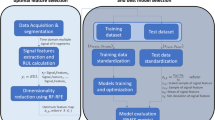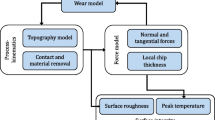Abstract
Prediction of machine tool failure has been very important in modern metal cutting operations in order to meet the growing demand for product quality and cost reduction. This paper presents the study of building a neural network model for predicting the behavior of a boring process during its full life cycle. This prediction is achieved by the fusion of the predictions of three principal components extracted as features from the joint time–frequency distributions of energy of the spindle loads observed during the boring process. Furthermore, prediction uncertainty is assessed using nonlinear regression in order to quantify the errors associated with the prediction. The results show that the implemented Elman recurrent neural network is a viable method for the prediction of the feature behavior of the boring process, and that the constructed confidence bounds provide information crucial for subsequent maintenance decision making based on the predicted cutting tool degradation.
Similar content being viewed by others
References
Djurdjanovic D, Ni J, Lee J (2002) Time–frequency based sensor fusion in the assessment and monitoring of machine performance degradation. ASME DSC Division 71:15–22
NSF I/UCRC Center for Intelligent Maintenance Systems (2002) Home page at: http://www.imscenter.net/
Lee J (1995) Machine performance monitoring and proactive maintenance in computer-integrated manufacturing: review and perspective. Int J Comput Integ Manuf 8:370–380
Lee J (1996) Measurement of machine performance degradation using a neural network model. Comput Ind 30:193–209
Engel SJ, Gilmartin BJ, Bongort K, Hess A (2000) Prognostics, the real issues involved with predicting life remaining. In: Proceedings of the IEEE Aerospace Conference, Big Sky, Montana, March 2000, vol 6, pp 457–469
Yang Z, Djurdjanovic D, Mayor R, Ni J, Lee J (2004) Maintenance scheduling in production systems based on predicted machine degradation. Automat Sci Eng (submitted, paper no V2004–067)
Zhang SF, Liu RJ (2000) A rapid algorithm for on-line and real-time ARMA modeling. In: Proceedings of the 5th International Conference on Signal Processing (WCCC-ICSP 2000), Beijing, China, August 2000, pp 230–233
Weigend AS, Huberman BA, Rumelhart DE (1990) Predicting the future: a connectionist approach. Int J Neural Syst 1:193–209
Rape R, Fefer D, Jeglic (1995) Comparison of neural networks to statistical techniques for prediction of time series generated by nonlinear dynamic systems. In: Proceedings of the Instrumentation and Measurement Technology Conference (IMTC/95), Waltham, Massachusetts, April 1995, pp 300–304
Lowe D, Zapart C (1999) Point-wise confidence interval estimation by neural networks: a comparative study based on automotive engine calibration. Neural Comput Appl 8:77–85
De Veaux RD, Schumi J, Schweinsberg J, Unger LH (1998) Prediction intervals for neural networks via nonlinear regression. Technometrics 40:273–282
Efron B, Tibshirani RJ (1993) An introduction to the bootstrap. Chapman and Hall, New York
Huang JTG, Ding AA (1997) Prediction intervals for artificial neural networks. J Am Stat Assoc 92:748–757
Lapedes A, Farber R (1987) Nonlinear signal processing using neural networks: prediction and system modeling. Los Alamos National Laboratory Report, Los Alamos, NM, technical report no. LA-UR-87-2662
Lee KY, Choi TI, Ku CC, Park JH (1994) Neural network architectures for short-term load forecasting. In: Neural Networks, proceedings of the IEEE World Congress on Computational Intelligence, Orlando, Florida, June/July 1994, pp 4724–4729
Senjyu T, Takara H, Uezato K, Funabashi T (2002) One-hour-ahead load forecasting using neural network. IEEE T Power Syst 17:113–118
Wulff NH, Hertz JA (1992) Prediction with recurrent networks. In: Proceedings of the 1992 IEEE-SP Workshop on Neural Networks for Signal Processing, Copenhagen, Denmark, August/September 1992, pp 464–473
Khotanzad A, Abaye A, Maratukulam D (1994) An adaptive recurrent neural network system for multi-step-ahead hourly prediction of power system loads. In: Neural Networks, proceedings of the IEEE World Congress on Computational Intelligence, Orlando, Florida, June/July 1994, pp 3393–3397
Logar AM, Corwin EM, Oldham WJB (1993) A comparison of recurrent neural network learning algorithms. In: Proceedings of the IEEE International Conference on Neural Networks, San Francisco, California, March 1993, pp 1129–1134
Rao SS, Sethuraman S, Ramamurti V (1992) A recurrent neural network for nonlinear time series prediction–a comparative study. In: Proceedings of the 1992 IEEE-SP Workshop on Neural Networks for Signal Processing, Copenhagen, Denmark, August/September 1992, pp 531–539
Chen CH, Yu L (1997) A learning algorithm for improved recurrent neural networks. In: Proceedings of the International Conference on Neural Networks (ICNN’97), Houston, Texas, June 1997, pp 2198–2202
Connor J, Atlas L (1991) Recurrent neural networks and time series prediction. In: Proceedings of the Seattle International Joint Conference on Neural Networks (IJCNN’91–Seattle), Seattle, Washington, July 1991, pp 301–306
Jenq-Neng Hwang, Little E (1996) Real time recurrent neural networks for time series prediction and confidence estimation. In: Proceedings of the IEEE International Conference on Neural Networks (ICNN’96), Washington, DC, June 1996, pp 1889–1894
Barton RS, Himmelblau DM (1997) Online prediction of polymer product quality in an industrial reactor using recurrent neural networks. In: Proceedings of the International Conference on Neural Networks (ICNN’97), Houston, Texas, June 1997, pp 111–114
Goh WY, Lim CP, Peh KK, Subari K (2000) A neural-network-based intelligent system for time-series prediction problems in product development. In: Proceedings of TENCON 2000, Kuala Lumpur, Malaysia, September 2000, pp 151–155
Jun Zhang, Tang KS, Man KF (1997) Recurrent NN model for chaotic time series prediction. In: Proceedings of the 23rd International Conference on Industrial Electronics, Control and Instrumentation (IECON’97), New Orleans, Louisiana, November 1997, pp 1108–1112
Zhang J, Man KF (1998) Time series prediction using RNN in multi-dimension embedding phase space. In: Proceedings of the IEEE International Conference on Systems, Man, and Cybernetics (IEEE SMC), San Diego, California, October 1998, pp 1868–1873
Seber GAF, Wild CJ (1989) Nonlinear regression. Wiley, New York
Cohen L (1995) Time-frequency analysis. Prentice-Hall, Englewood Cliffs, New Jersey
Author information
Authors and Affiliations
Corresponding author
Additional information
NSF Industry/University Cooperative Research Center (NSF I/UCRC) forIntelligent Maintenance Systems(IMS).
Rights and permissions
About this article
Cite this article
Yu, G., Qiu, H., Djurdjanovic, D. et al. Feature signature prediction of a boring process using neural network modeling with confidence bounds. Int J Adv Manuf Technol 30, 614–621 (2006). https://doi.org/10.1007/s00170-005-0114-x
Received:
Accepted:
Published:
Issue Date:
DOI: https://doi.org/10.1007/s00170-005-0114-x




